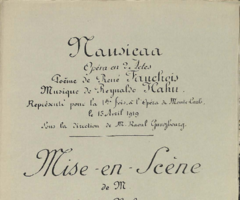Nausicaa
Opera in 2 acts, first performed on 13 April 1919 at the Monte-Carlo Opera House.
Shortly after the First World War, Prince Albert I of Monaco decided to honour France at the annual gala performance held at Monte-Carlo Opera House. Three French composers were duly commissioned to provide works for the event: Gabriel Fauré composed Masques et Bergamasques, Claude Terrasse Le Mufti and Reynaldo Hahn Nausicaa. René Fauchois’s libretto for Nausicaa was inspired by an episode from Homer’s Odyssey. Shipwrecked on the island of Phaeacia, Ulysses meets Princess Nausicaa, who takes him to the royal palace. In Act II Ulysses, listening to the epic story of the Trojan War, reveals his identity, then departs for Ithaca, leaving Nausicaa in tears. The literary subject matter and the high quality of the libretto lent themselves particularly well to a musical setting. Hahn, who had volunteered for service in the French Army, began work on the score while at the front, during brief lulls in the fighting, in the villages of Auzéville and Vraincourt; he mentions this on the manuscript. His music for Nausicaa, very noble in style, makes the most of the orchestral, dramatic and choreographic possibilities afforded by the libretto. The emotion of the work culminates in the final scene with Ulysses’s departure and the princess’s sorrow. The roles, which are quite demanding, require the singers’ full vocal capacities. A dance in Act II is appropriately based on an ancient melodic motif that Hahn learned from a goatherd in Constantinople. At its première in Monaco on 13 April 1919, the work was a great success. Later, in June 1923, it was revived in Paris at the Opéra-Comique.

